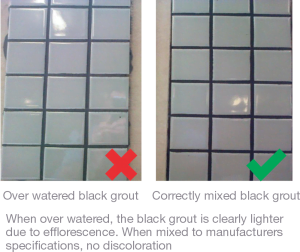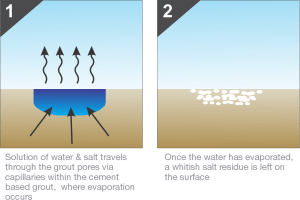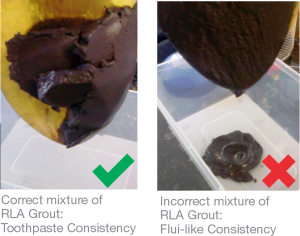Efflorescence – Causes & How to avoid it!
As manufactures of quality cement based tile adhesives and grouts, every so often we will have a client contact us asking “ Why is my grout patchy” or “The colour is lighter than what I chose” or “ A white residue has appeared over the grout”. The above statements are typical signs of Efflorescence.
What does Efflorescence look like?
Efflorescence is generally described as a whitish powder or crusty deposit on the surface of the grout joint. Efflorescence can appear as patches or all over the entire grouted area, or just isolated to one area depending on various causes.
Efflorescence is more prevalent in darker colours simply because the white salt residue is highlighted on a dark background (grout joint).
Efflorescence occurs in all cement-based products and not restricted to grouts.
What causes Efflorescence?
Efflorescence can occur due to multiple factors; usually the catalyst for Efflorescence is climatic or excessive amounts of water.
Climatic– Efflorescence does occur more regularly in the cooler months. This is due to the water that is used to mix grout remains in the grout for a longer than desired period, enabling the soluble salts (free lime) in the cement to easily migrate to the surface.
Mixing:
More commonly Efflorescence is promoted when excessive amounts of water is added to the grout upon mixing or even on clean up. Eg. 10kg bag of RLA Coloured Grout should only be mixed using 3-3.2L of clean water, no more! When overwatering occurs, the mixture is so saturated with water, this will introduce air entertainment and all soluble salts within the cement in the grout easily migrate to the surface.
Cleaning:
Proper cleaning of excess grout residue is essential to achieving the desired grouting for your floor. Once the grout has been mixed and installed in accordance with the manufacturer’s instructions, the following cleaning method is recommended in-order to achieve grout satisfaction.
1) Using a clean sponge apply water to the sponge then drain it thoroughly until the sponge is damp not dripping wet.
2) Avoid over cleaning, once most of the grout residue has been removed from the surface of the tiles, stop cleaning, don’t worry about minor residue that may be left behind this should clean up nicely the next day by buffing with a dry cloth or rag.
3) Avoid using wet cleaning methods like wash boy’s, these leave too much water on grout joints, which then re wets the grout causing a candle wick effect drawing up the salts from the Substrate, adhesive and grouts to cause Efflorescence.
4) When using RLA Coloured Grout on glossy tiles, there is no need to over clean, as this will only introduce more water onto the surface of the grout.
5) Remember minor grout residue left on the tile will easily clean up the next day using a soft dry rag or cloth.
How to avoid Efflorescence in Cementitious Based Grouts?
Efflorescence is an issue, which has no guaranteed solution; Preventative measures will assist in reducing Efflorescence. What to Do?
Surface preparation:
1) If tiling on concrete, ensure that the substrate is fully cured before any tiling can commence.
2) If tiling over sand cement screed allow the screed to cure for 7 days before tiling. Residual moisture in cement will evaporate and may cause Efflorescence to occur.
3) Check for rising damp.
4) If substrate has higher levels of moisture or is still “green”, installing an epoxy moisture barrier is highly recommended.
5) Allow Tile Adhesive to cure before grouting
6) Correct mixing of RLA Coloured Grout, 3-3.2L of water.
7) Where possible, always use a Synthetic or Epoxy grout product that has no Portland cement, these products will not effloresce.
In order to greatly reduce the Efflorescence in RLA Coloured grouts, the grout must be mixed correctly. Consistency should be that of toothpaste and hang on the grout squeegee.
Any grout including RLA Coloured Grout that is incorrectly mixed where too much water is added, making it into a fluid like consistency, increases the chances of Efflorescence occurring.
RLA Coloured Grout is a highly modified grout that has specialised additives that help to reduce the occurrence of Efflorescence. RLA Coloured Grout performance has been thoroughly examined by reputable independent testing companies.
Results show that RLA Coloured Grout complies with Australian and International standards AS/ISO13007.3-2013, as a CG1 type grout.
This means that RLA Coloured Grouts are considered to be of extremely high performance.
The classification CG1 comes after rigorous and repeatable testing has been completed.
Remember
Efflorescence is due to excessive amounts of water, humidity, cooler climates and dampness in substrate or adhesive. Tilers should take care to force the grout deep into the bottom of the joint. If Tile Adhesive has filled part of a joint, rake the joint out before grouting.
Try to eliminate the above factors, as this will greatly reduce Efflorescence.






